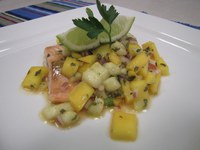Prairie Fare: Try the Stairs More Often
(Click an image below to view a high-resolution image that can be downloaded)
By Julie Garden Robinson, Food and Nutrition Specialist
NDSU Extension Service
“Mom, let’s use the stairs,” my 12-year-old daughter said.
“But we are on the 18th floor,” I replied. We were surveying the city of Bismarck from the observation deck of the state Capitol building.
“You always say that people should use the stairs instead of the elevator,” she reminded me with a giggle.
I couldn’t argue with that point.
“I really don’t like elevators, either. Do you know how thin those elevator cables are? What if the cable snaps when we are going down?” she noted.
Now she’s using fear tactics, I thought to myself. We found the exit door and began walking down the steps.
“Are you going to take care of me when I need knee-replacement surgery?” I asked dramatically as we rounded the 9th floor, which represented 180 steps of our journey to the ground floor.
“This is good exercise, Mom!” she said enthusiastically.
When we emerged with our joints still intact, I took her picture with the building in the background.
“We were up that high?” she remarked.
Walking up and down steps is a good form of exercise. If your joints can handle it, taking the steps instead of the elevator can help with weight management and tone and strengthen your muscles.
Walking up steps burns more calories than walking down steps. For example, a 150-pound person would burn about 50 calories in 10 minutes when walking down steps. If that same person spent 10 minutes walking up steps, he or she would burn about 100 calories.
Walking up steps is particularly good exercise for the muscles at the front of your thighs (quadriceps) and your backside (gluteus maximus).
We all rely on good joint health for easy movement. Joints are made up of cartilage and a lining called synovium. Joints cushion our bones and allow free movement.
Most of us know someone who suffers from osteoarthritis, which affects an estimated 27 million Americans. Osteoarthritis is known as the “wear-and-tear” joint disease. Overuse and repetition often are to blame, but some diseases, some medications and normal wear and tear all can promote deterioration of our joints.
Maintaining a healthy weight places less strain on your joints, and exercise is a key to weight maintenance.
Water aerobics, swimming, cross-country skiing and biking are examples of joint-friendly fitness activities. Be sure to stretch before exercising and try low-impact exercise, not bouncing movements.
On the nutrition side, drink plenty of water to help prevent dehydration and keep joints lubricated. Eat a balanced diet with plenty of fruits, vegetables and foods containing omega-3 fatty acids, such as salmon, tuna and walnuts, to promote joint health and overall health.
For additional information and resources, see “Nourish Your Joints,” a publication of the NDSU Extension Service available at http://www.ag.ndsu.edu/pubs/yf/foods/fn1489.pdf.
This recipe is a good source of omega-3 fats, vitamin A, antioxidants and vitamin C.
Salmon With Mango Salsa
4 (6-ounce) salmon fillets, thawed
2 Tbsp. olive oil
1 mango, peeled, pitted, diced
1 cucumber, seeded, diced
1/2 c. tomato, seeded, diced
1/4 c. fresh cilantro, chopped
1/4 c. red onion, chopped
2 Tbsp. lime juice
2 tsp. lime peel, grated
Pinch of cayenne pepper (optional)
Salt and pepper (to taste)
Brush salmon fillets evenly with 1 Tbsp. of oil. Cook salmon according to package directions in an oven, on the grill or with an electric grill. Fish should flake with a fork and/or reach an internal temperature of 145 F.
To make salsa, combine all other ingredients in a small bowl. Mix in 1 Tbsp. oil. Season salsa with salt and pepper. Serve salmon with mango salsa.
Makes eight servings. Each serving (without added salt) has 230 calories, 14 grams (g) of fat, 19 g of protein, 6 g of carbohydrate and 55 milligrams of sodium.
(Julie Garden-Robinson, Ph.D., L.R.D., is a North Dakota State University Extension Service food and nutrition specialist and associate professor in the Department of Health, Nutrition and Exercise Sciences.)
NDSU Agriculture Communication – March 17, 2011
| Source: | Julie Garden-Robinson, (701) 231-7187, julie.garden-robinson@ndsu.edu |
|---|---|
| Editor: | Rich Mattern, (701) 231-6136, richard.mattern@ndsu.edu |



